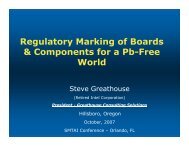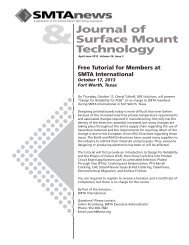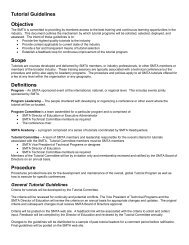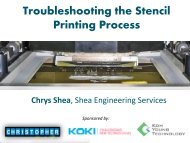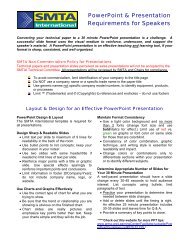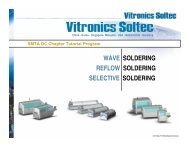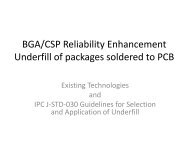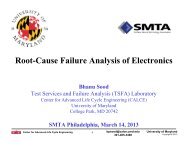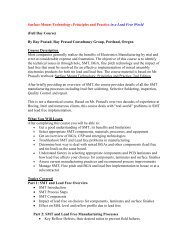Lead Free Soldering - SMTA
Lead Free Soldering - SMTA
Lead Free Soldering - SMTA
You also want an ePaper? Increase the reach of your titles
YUMPU automatically turns print PDFs into web optimized ePapers that Google loves.
DFX FOR LEAD FREE PROCESSING<br />
AND RELIABILITY<br />
Presented By: Dale Lee<br />
E-mail: Dale.Lee@Plexus.Com<br />
1
WHAT DOES LEAD FREE MEAN TO YOU<br />
Original RoHS Directive - Originally 8<br />
Categories<br />
RoHS2 Directive:<br />
Categories 8 (Medical Devices) & 9<br />
(Monitoring and Control<br />
Instrumentation) Are Now In Scope<br />
22-July 2014 – General Medical Devices<br />
22 July 2016 – In Vitro Medical Devices<br />
Active Implantable Devices<br />
• Out Of Scope At This Time<br />
• Review For Inclusion In 2020<br />
Defense Excluded From<br />
Specification<br />
2
TECHNOLOGY DRIVEN DESIGNS<br />
Component packaging technology trends:<br />
• Decrease in size (length, width, thickness)<br />
• Increase in functionality (electrical, optical, electrical mechanical and<br />
mechanical)<br />
• Interconnection density per unit area is increasing (increased number of<br />
layers, smaller lines and spaces)<br />
• Assembly functional performance is increasing (thermal, mechanical,<br />
electrical)<br />
Assembly process complexities continue to increase and LEAD FREE Soldered<br />
3
LEAD FREE SOLDER ADVANTAGES<br />
Material Costs<br />
• NO<br />
– More Expensive<br />
Reflow Temperature<br />
• NO<br />
– Higher Temperatures For Reflow & Rework<br />
– Increased Component & PCB TCE Mismatch (Warp, Crack)<br />
– Increased Z-axis Expansion<br />
Through Hole <strong>Soldering</strong><br />
• NO<br />
– Higher Hand and Rework Solder Temperature<br />
– Greater <strong>Lead</strong> to Hole Clearance<br />
– Increased Copper Dissolution<br />
Assembly Process Physics<br />
• Yes<br />
– Tighter SMT <strong>Lead</strong> Pitch Packages<br />
– Increased Secondary Side SMT Package Mass<br />
– Decreased Tombstone Components<br />
– Increased Off Pad Printing Compatibility (Pin-in-Paste)<br />
Reliability<br />
• Maybe<br />
– Dependant Upon Environmental Conditions.
MEET FUNCTIONAL AND LEGISLATIVE REQUIREMENTS<br />
RoHS/non-RoHS compatible analysis ensures compliance with regulatory and<br />
product reliability and assembly requirements<br />
Not all RoHS compliant components are lead free soldering process compatible<br />
Not All RoHS compliant components are backward compatible with tin/lead<br />
solder process<br />
RoHS & Green Information<br />
Part #<br />
Supplier<br />
<strong>Lead</strong>-<br />
<strong>Free</strong><br />
RoHS<br />
RoHS<br />
Exemption<br />
RoHS<br />
Exemption<br />
Type<br />
Component<br />
Engineer<br />
Comment<br />
Terminal<br />
Plating<br />
MSL<br />
Max<br />
Temp<br />
C of C/<br />
Datasheet<br />
C0402C102K3RACTU<br />
RK73H1ETTP1002F<br />
NACE221M<br />
10V8X6.5TR13F<br />
Kemet<br />
Electronics<br />
KOA Speer<br />
Electronics<br />
Compliant Compliant No Matte Sn 1 260°C Link<br />
Not<br />
Compliant<br />
Compliant Yes 7.c-1 Matte Sn 1 260°C Link<br />
NIC Compliant Compliant Matte Sn 1 235°C Link<br />
0402YA331JATAT2A AVX/Kyocera Compliant Compliant Sn/Bi 1 260°C Link<br />
5
LEAD FREE ASSEMBLY IMPACTS TO PCB LAMINATE<br />
Traditional G10 and FR4 printed circuit board laminates cannot survive multiple<br />
elevated lead free soldering process exposure or sustain impact to reliability<br />
IPC Material Specifications (IPC-4101) For Epoxy Glass <strong>Lead</strong> <strong>Free</strong> Laminates are:<br />
IPC-4101 /126 or /129 – Halide Flame Retardant (FR4), 170 Tg<br />
IPC-4101 /130 or /131 – Low Halide Flame Retardant, 170 Tg<br />
Severity of reliability impacts are influenced by:<br />
• Assembly process thermal exposure conditions<br />
• Board design – number of layers, conductor routing<br />
• Component package types<br />
• Conductor / component placement density<br />
• Operational environment<br />
Photos courtesy of Cookson and<br />
Universal Instruments<br />
6
MICRO-VIA DESIGN – RELIABILITY IMPACTS<br />
Different Via Hole<br />
Structures<br />
Impact<br />
Resistance To<br />
Assembly,<br />
Rework or<br />
Handling<br />
Damage<br />
Design and Construction Affects on PWB Reliability, Paul Reid,<br />
IPC Apex Proceedings 2012.
PRINTED CIRCUIT BOARD FINISHES<br />
Final printed circuit board finish impacts<br />
the ability to solder surface mount and<br />
through holes components reliably and<br />
cost effectively.<br />
Assembly Characteristics<br />
<strong>Lead</strong><br />
<strong>Free</strong><br />
HASL<br />
OSP<br />
Immer<br />
Silver ENIG ENEPIG<br />
Fine Pitch <strong>Lead</strong>ed SMT Components Neutral Plus Plus Plus Plus<br />
Chip Components (Passives)* Plus Plus Plus Plus Plus<br />
Area Array (BGA/CGA) Plus Plus Plus Plus Plus<br />
Reflow & Wave Soldered (SMT & PTH) Plus Neutral Plus Plus Minus<br />
Wave Soldered PCB (SMT and PTH Components) Plus Neutral Neutral Plus Minus<br />
Wave Soldered PCB (PTH Components Only) Plus Neutral Neutral Plus Minus<br />
8
LEAD TO HOLE CLEARANCE<br />
<strong>Lead</strong> Angle In Hole Combined With<br />
<strong>Lead</strong> Clearance, <strong>Lead</strong> Shape And<br />
Flux Quantity Can Impact Void<br />
Creation In Plated Through Hole.<br />
• <strong>Lead</strong> Type Can Impact Void Creation<br />
– Round Versus Flat Ribbon<br />
• <strong>Lead</strong> / Hole Metallization Can Impact<br />
Void Creation<br />
– Faster Wetting Rate = Greater Risk<br />
Of Void Creation *<br />
K. Seelig, et al, “<strong>Lead</strong>-<strong>Free</strong> Solder Assembly For Mixed<br />
Technology Circuit Boards”, <strong>SMTA</strong>-I 2006
LEAD TO HOLE CLEARANCE<br />
<strong>Lead</strong> <strong>Free</strong> <strong>Soldering</strong><br />
• <strong>Lead</strong> Clearance Minimum May<br />
Increase<br />
• Increasing Board Thickness May<br />
Further Increase <strong>Lead</strong> To Hole<br />
Clearance (Aspect Ratio)<br />
• Larger Holes Create Less Voids<br />
Smaller <strong>Lead</strong> To Hole Clearance<br />
Decreases Shrinkage Holes /<br />
Hot Tear Joints<br />
IPC-A-610D, Fig. 5.67
INTERNAL PCB IMPACTS<br />
Number of layer connections to plated<br />
through-hole<br />
• Increased number of layer<br />
connections increases thermal<br />
mass of plated through-hole<br />
• Increased number of plane layer<br />
connections greatly increases<br />
thermal mass of plated throughhole<br />
• Increase thermal pad isolation to<br />
improve solder flow to topside<br />
Higher solder temperatures or<br />
increased solder dwell times create<br />
problems with pads on solder side<br />
11
WAVE SOLDER & REWORK ISSUES<br />
Limit Effects Of Copper Dissolution<br />
Use Lower Dissolution Rate<br />
Solder Alloy<br />
• Modified SAC Alloy<br />
(Sb, Ni, Zn, Ge, In, Etc)<br />
• Non-SAC Alloy<br />
(Sn/Cu/Ni, Etc)<br />
Original<br />
SnPb<br />
0.005” Trace Dissolution in 30 Seconds<br />
Pad Trace Connection<br />
– Tear Drop<br />
– Snow Man Connection<br />
– Wide Trace<br />
– Greater Than 0.010”<br />
SAC 305<br />
SN100C<br />
After wave soldering, 265 o C<br />
solder temperature, 12 seconds<br />
contact time<br />
PCB Photo Courtesy of Cookson – Alpha Metals<br />
Byle, Jean & Lee, “Copper Dissolution Rate in Pb-<strong>Free</strong> <strong>Soldering</strong> Fountain Systems”,<br />
<strong>SMTA</strong>-I 2006
THROUGH HOLE PAD DESIGN<br />
Square Pads Should Not Be Used On Solder Side<br />
Increased Pad Lifting*<br />
Increased Solder Defect – Bridge/Flag/Web<br />
Decrease Component / Top Side Pad Size**<br />
Reduced Fillet Lifting<br />
* Dr. S. Zweiger, Solectron GMBH, Productronica Green Day, November 2005<br />
** K Puttlitz, K Stalter, “Handbook of <strong>Lead</strong>-<strong>Free</strong> Solder Technology For Microelectronic Assembly”, pp 628, Fig 48
THROUGH HOLE PAD DESIGN<br />
All Pads Should Be Same Shape<br />
• Oval or Round<br />
• Pin 1 square pad should not be used on solder<br />
side<br />
• In some situation legend ink in between pads<br />
can help to minimize solder bridges<br />
High Density Components (< 2mm Pitch)<br />
• Pads Should Be Oval In Shape<br />
• Staggered Pad Designs Should Be Used To<br />
Enhance Solder Joint Formation On Exit Side Of<br />
Component
SOLDER MASK SELECTION IMPACT<br />
A Low Surface Energy “Glossy” Finish Can Generate<br />
Solder Defects Similar In Appearance Of No Flux Or<br />
Too Little Flux On The Board.<br />
Resulting in Whiskers, Strings, Peaks, Bridges, Icicles,<br />
Solder Balls, Solder Web, Solder Flags
DEFECTS CAUSED BY IMPROPER THERMAL BALANCE<br />
Wave Solder Process<br />
Thermal Shock<br />
Damage<br />
LED lead<br />
LED<br />
Increase Thermal Pad<br />
Isolation<br />
Balance Number<br />
Connections For<br />
Component Per Each<br />
Plated Through Hole<br />
Uniformity Of Trace<br />
Size Connection To<br />
Component Plated<br />
Through Hole
THROUGH-HOLE COMPONENT MOUNTING<br />
<strong>Lead</strong>s Should Extend Below<br />
Bottom of Board<br />
<strong>Lead</strong> Protrusion: Shorter is<br />
Better<br />
• Decreased Solder Bridging<br />
• Decreased Component Tilting<br />
<strong>Lead</strong> <strong>Free</strong> Solder:<br />
• <strong>Lead</strong> Length Should Be Even Shorter<br />
Than Tin-<strong>Lead</strong> Solder.
EFFECT OF BOARD THICKNESS ON TOPSIDE FILLET<br />
FORMATION<br />
Board thickness increase thermal<br />
mass of plated through-hole<br />
Increase thermal pad isolation to<br />
improve solder flow to the top<br />
side<br />
Increase lead hole clearance<br />
(aspect ratio) to improve solder<br />
flow to top side<br />
0.062”<br />
0.100”<br />
0.150”<br />
Board Thickness
Are You Confused<br />
About Design For<br />
Manufacturing<br />
Requirements In<br />
Today’s <strong>Lead</strong> <strong>Free</strong><br />
<strong>Soldering</strong> World<br />
QUESTIONS SO FAR
COMPONENT PACKAGING AND DESIGN IMPACTS<br />
0.2 mm<br />
0.4 mm<br />
0.8 mm<br />
1.0 mm<br />
Increased use of leadless component packaging technology<br />
• Ball Grid Array (BGA)<br />
• Quad Flatpack No-lead (QFN)<br />
Increased sensitivity component/printed circuit board flatness<br />
• Internal split plane or partial plane<br />
• Nonfunctional pad removal<br />
Increased use of component packaging with finer lead pitches<br />
• 0.65mm > 0.5mm > 0.4mm > 0.35mm > 0.3mm > <br />
1.27 mm<br />
20
SOLDER MASK DESIGN AND FABRICATOR INCONSISTENCY<br />
Non-solder mask defined (NSMD)<br />
• Size of pad defined by copper pad and interconnections<br />
(variable size)<br />
• Solder encapsulates pad<br />
• Limited to components with lead pitch greater than 0.4mm<br />
Solder mask defined (SMD)<br />
• Size of pad defined by solder mask opening (uniform size)<br />
• Solder covers exposed pad (fills opening)<br />
• Required for components with lead pitch 0.4mm or less<br />
• Preferred for leadless array devices like land grid arrays,<br />
multi-row quad flatpack no-leads, etc<br />
Solder mask fabrication consistency<br />
• Fabrication note interpretation “No solder mask permissible<br />
on pads unless provided this way on supplied artwork”<br />
• Selective solder mask opening changes between PCB<br />
suppliers<br />
21
ETCH IMPACTS OF SMALLER COMPONENT PACKAGES<br />
Increased PCB supplier control/capability understanding may be required to<br />
ensure proper etch compensation values are applied to other surface features and<br />
not to conductor patterns.<br />
Supplier A<br />
Percentage reduction by pad size<br />
Supplier B<br />
22
IMPACTS OF INTERCONNECT DESIGN<br />
Placement and types of vias in pad can affect assembly solder joint formation<br />
More of an impact on smaller components and/or lower number<br />
of electrical connections<br />
Design and Construction Affects on PWB Reliability,<br />
Paul Reid, IPC Apex Proceedings 2012.<br />
23
STACKED VIA IN PAD FAILURE MODE<br />
<strong>Lead</strong> free laminate is less ductile<br />
<strong>Lead</strong> free solder is less ductile<br />
Increased stress transmission to<br />
internal connections<br />
• Test fixture<br />
• Assembly fixtures<br />
• System integration<br />
• Environmental<br />
24
BOTTOM TERMINATE COMPONENT SENSITIVITY<br />
Components without leads are more sensitive to minor design and assembly<br />
process changes<br />
• Land pattern design<br />
– Exposed pad size uniformity<br />
• Component /printed circuit board flatness/warping<br />
– Copper distribution under package<br />
• Paste volume control<br />
– Pad to pad volume<br />
– Pad to design defined volume<br />
25
COMPONENT ISSUES - WARPAGE<br />
Higher <strong>Lead</strong> <strong>Free</strong> Solder Solidification and Process Temperatures,<br />
Increases The Amount Of Thermal Expansion Mismatch Of<br />
Components Which Can Increase Amount Of Component Warping<br />
During Assembly Process<br />
May Require Redesign Of Package (Material Selection) For Thermal Mass And<br />
Expansion Balance.
COMPONENT ISSUES – WARPAGE & THERMAL SHOCK<br />
May Require Change In Production<br />
Process<br />
Tooling To Bridge Warpage Gap.<br />
(Increased Solder Paste Volume Application, etc.)<br />
Reflow Profile To Bridge Warpage Gap.<br />
(Decreased Thermal Change Rate – Reduce Surface To<br />
Cooler Location Temperature Delta - TCE Induced<br />
Warpage)<br />
Reflow Profile To Reduce Micro Cracks In<br />
Multilayer Ceramic Capacitor Chips & Arrays.<br />
(Decreased Thermal Change Rate – Reduce Surface To<br />
Cooler Location Temperature Delta For Chip > 1210)
COMPONENT PAD - THERMAL IMBALANCE<br />
Multiple trace connections<br />
• Trace connections per pad<br />
• Uniformity across all pads on<br />
single component<br />
Solder mask defined pad<br />
increased soldering defects<br />
• Delayed reflow across surface<br />
mount technology components<br />
– Tombstone components<br />
– “Ball in socket” area array<br />
component<br />
28
COMPONENT PAD - THERMAL IMBALANCE<br />
Small Passive Component Pad Design<br />
• Mixed Solder Mask Defined<br />
– Multiple/Large Trace<br />
– Exposed Plane<br />
• Smaller Component Package, The Greater The Impact
COMPONENT PAD - THERMAL IMBALANCE<br />
“Via in pad” placement may<br />
create mounting pad height<br />
differences<br />
• More of an impact on smaller<br />
and/or lower lead count or<br />
leadless (no solder ball/solder<br />
bump) component packages<br />
30
STENCIL TO PCB ALIGNMENT<br />
Smaller components decrease total PCB and assembly process tolerance<br />
Minor misalignment can impact process yields<br />
3 mil<br />
6 mil<br />
31
TIN-LEAD AND LEAD FREE SOLDER DIFFERENCES<br />
Stencil alignment of solder<br />
paste to pad tolerance may be<br />
critical to good manufacturing<br />
yields<br />
(Dependant upon PCB surface<br />
finish)<br />
Tin-lead paste<br />
<strong>Lead</strong> free paste<br />
Alpha Metals, SMT Mag Webcast<br />
January 2006<br />
32
TIN-LEAD VS LEAD FREE WICKING<br />
Depending upon the pairing of PCB surface finish and component lead finish, the<br />
amount of solder wicking/spread can induce or reduce solder defect formation<br />
with lead free soldering process<br />
Copper, tin, silver and gold <strong>Lead</strong> free Tin-lead<br />
33
TO CLEAN OR NOT TO CLEAN<br />
Ability to remove soldering process residues from PCBs may change due to<br />
• Component package type<br />
• Component size<br />
• Solder mask design<br />
34
TEST POINT AND SUPPORT DISTRIBUTION<br />
Determines probe accessibility to the various components/nets for<br />
the purpose of in-circuit testing and concentrate test probe stress<br />
into localized area.<br />
• Fixture induced printed circuit board bending during test<br />
• Fixture induced bending during functional test from connector<br />
mating/unmating.<br />
35
MECHANICAL STRESS/STRAIN IMPACTS<br />
Mechanical stress/strain impact analysis to identify test-initiated potential latent<br />
field failure modes<br />
• Solder joint crack initiation or fracture<br />
• Micro/buried via design impacts<br />
– Surface copper cracking/separation<br />
– Internal copper cracking/separation<br />
• Mechanical strain concentration<br />
– Test point concentration<br />
– Final assembly/disassembly<br />
36
EXAMPLE OF EXCESSIVE STRESS<br />
BGA Connection Near J5<br />
• Bottom 3 Solder<br />
Connections<br />
• Two (2) Rows Of Solder<br />
Balls<br />
K<br />
L<br />
M<br />
1<br />
2<br />
37
THANK YOU!<br />
Dale Lee<br />
Dale.Lee@Plexus.Com
QUESTIONS<br />
39



